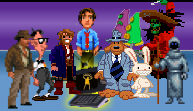



 |
Introduction
Introduction Changes
What is SCUMM?SCUMM, the Script Creation Utility for Maniac Mansion, is an engine for creating graphics adventure games.It is well known that the best way to perform some very complex task is to start out by building a tool to help you with that task. In the same way, two programmers at LucasArts back in 1988 decided that rather than write a single, complicated program for their new graphic adventure game, they should instead build an generic engine that would play any graphic adventure game, if given the proper data files; this would let them concentrate on the game design, rather than the details of the programming. It worked. And so SCUMM was born. The way the SCUMM engine works is that there is a single executable program, called the interpreter, that operates on some data files. The data files contain images, dialogue, details of object behaviour, and so on. The interpreter then brings all this to life and handles the details of drawing it all, animating the characters, processing user input, and all the other details that a graphic adventure game needs dealt with in order to work properly. Because the data files contain no executable code, it turns out to be trivial to port the game to a new platform: just port the interpreter, and use the same data files. You will get exactly the same game on the new system. A lesson many people have learnt. Infocom, creators of possibly the finest text adventure games of all time, did a very similar trick with their Z-machine; you can now get Z-machine interpreters for everything from a Cray Supercomputer to a Game Boy, all of which will play Infocom's games, encoded in the data files. See Brass Lentern for more information. Aric Wilmunder and Ron Gilbert's original SCUMM has been expanded a bit since 1988, of course. Every time a game required some feature that SCUMM had not previously supported, the interpreter was extended and the data file format expanded. The whole system was redesigned from scratch twice. Even now that LucasArts has finally retired SCUMM for their latest games, such as Grim Fandango, the interpreter/data file philosophy is still in use and you can see SCUMM design decisions in the data file format. This document attempts to document the SCUMM data file format. With reasonably complete documentation, it becomes possible to do all sorts of exiting things: like write a free, portable interpreter that will play and SCUMM game on any platform (such as ScummVM, written by Ludvig Strigeus and the ScummVM team), or to create your own SCUMM games from scratch. The information obtained here was almost all obtained by other people. All I have done is to collate it into one place. Among the many who have been working on the SCUMM file format, Ludvig Strigeus, Jimmi Th�gerson and Peter Kelly have performed incredible tasks of reverse-engineering, and I am indebted to them. Jimmi Th�gerson and Peter Kelly have developed their own SCUMM file browsing and analysis tool called SCUMM Revisited. If you are at all interested in SCUMM files, this is an essential tool. What versions of SCUMM are there available?Many. SCUMM is a LucasArts in-house standard. The format was never designed to be public and so would change unpredictably from game to game to suit the task at hand. The first LucasArts adventure games used an unknown format that is now lost with time. We will ignore it because it wasn't really SCUMM as we know it know, wasn't very good, anyway, and only worked on the Commodore 64. The first PC versions started with V2 and a variation of the V1 format. With Indiana Jones and the Last Crusade, LucasArts developed a modular file format based loosely on the standard IFF format. This was used several times in various forms until The Secret of Monkey Island, where the SCUMM engine and file format was redesigned from scratch. The new format was used from then on, and vestiges of It are still visible in the latest LucasArts games such as Grim Fandango. The full list of games and versions follows. Game versions
|